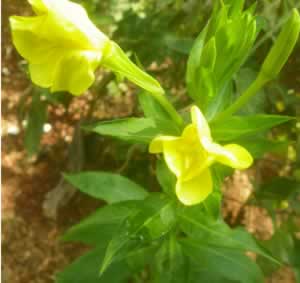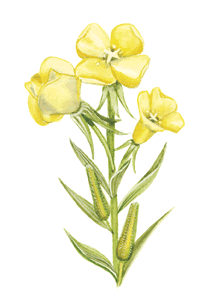Evening Primrose Oenothera biennis

Evening primrose flowers
- Common Names
- Evening Primrose Oil , Night Willow-herb
- Botanical Name
- Oenothera biennis
- Family
- ONAGRACEAE
Medicinal Uses & Benefits of Evening Primrose Oil
![]() How to Use|
Side Effects |
Plant & Garden|
How to Use|
Side Effects |
Plant & Garden|
- Medicinal Uses: * Cancer Prevention
* Eczema
* Hypertension
* Nerve/Back Pain
* PMS
* Rheumatoid_arthritis
- Properties: * EFA
- Parts Used: oil from seeds
- Constituents: fatty acids :gamma linolenic 9.2%,linoleic 74.6%,oleic 6.7%, palmitic 6.2%
How to Use: Evening Primrose
Borage is a member of the same family as comfrey. The plant contains potassium and calcium combined with mineral acids. Borage leaf may be useful for gently strengthening adrenal functions, the older herbalist wrote glowing accounts of the invigorating properties of the fresh leaf. "According to Dioscorides and Pliny, Borage was the famous Nepenthe of Homer, which when drunk steeped in wine, brought absolute forgetfulness." (Grieve, Margaret)
Evening primrose seeds contain a fragrant oil that plays an important part natural health. The seed oil contains gamma-linolenic acid (GLA), an omega-6 fatty acid that the body uses to manufacture a prostaglandin vital to soothing inflammation and supporting the immune system. It also helps keep the blood flowing freely, reduces high blood pressure, plays a role in reducing breast cancers1,and lowers cholesterol.
Evening primrose oil is a prized oil in aromatherapy skin care because of its many health benefits.
Evening primrose grown in the garden provided access to the fresh stems and leaves which are demulcent and soothing both to irritated skin and for an irritable stomach. 3
Preparation Methods & Dosage : Evening Primrose seed oil may be taken as a supplement form or used as a salad and vegetable dressing. Also great for skin care. Do not heat. Leaves and stems from the top of the plant can be used in decoctions for both internal and external use.
Evening Primrose Remedies
 In the Kitchen: The roots of the Evening Primrose are eaten in some countries in the spring, and the French often use it for garnishing salads.4
In the Kitchen: The roots of the Evening Primrose are eaten in some countries in the spring, and the French often use it for garnishing salads.4
Evening Primrose Side Effects: Suitable for food and cosmetic use, however bloating or abdominal upset may occur from the excessive use of Evening Primrose Seed Oil internally.
Plant Description

- Plant Class:Biennial
- Etymology: From the Greek oinos - wine, and thera -hunt. Name given by Theophrastus for a plant whose roots are eaten to arouse desire for wine
- Flowers/Fruit/Seeds:Deeply scented evening blooming flowers, followed by downy pods containing seeds. Flowers are 1 to 2 in. across, borne in terminal leafy-bracted spikes. Calyx: tube slender, elongated, gradually enlarged at throat, the 4-pointed lobes bent backward; corolla of 4 spreading petals; 8 stamens; 1 pistil; the stigma 4-cleft.
- Parts used: Seeds for oil
- Leaves: Leaves: Alternate, lance-shaped, mostly seated on stem, entire, or obscurely toothed
- Flowering Season: June to October
- Distribution: Native to North American, widely naturalized. Related to the willow herbs, Epilobium , but not primroses, Primula
Like a ball-room beauty, the Evening Primrose has a jaded, bedraggled appearance by day when we meet it by the dusty roadside, its erect buds, fading flowers from last night's revelry, wilted ones of previous dissipations, and hairy oblong capsules, all crowded together among the willow-like leaves at the top of the rank-growing plant. But at sunset a bud begins to expand its delicate petals slowly, timidly, not suddenly and with a pop, as the evening primrose of the garden does. Now, its fragrance, that has been only faintly perceptible during the day, becomes increasingly powerful. Why these blandishments at such an hour? Because at dusk, when sphinx moths, large and small, begin to fly, the primrose's special benefactors are abroad.
If a flower has not been pollinated during the night it remains open a while in the morning. Bumblebees now hurry in, and an occasional humming bird takes a sip of nectar. Toward the end of summer, when so much seed has been set that the flower can afford to be generous, it distinctly changes its habit and keeps open house all day.
1Regional Traditions :European * North America *
How to Grow Evening Primrose
Does well in poor soil, hardy and drought tolerant once established. Full sun to part shade, tall plants, use in wild flower plantings or back of the garden. Self seeds freely.
- Dr Javier Menendez . "Plant oil acts like cancer drug".(2005-11-02) BBC News.
- Netje Blanchan. Wild Flowers worth Knowing (1917)
- W. T. Fernie ,M.D. 1897. "Herbal Simples Approved For Modern Uses Of Cure"
- Maud Grieve. "A Modern Herbal Vol I & II",(1931)
Scientists have pinpointed how evening primrose oil fights breast tumours. A substance in the oil called gamma-linolenic acid (GLA) that acts on the same receptor in tumours as the powerful breast cancer drug Herceptin. Unlike Herceptin, which blocks the Her-2/neu receptor, GLA interferes with the gene carrying the DNA code needed to make the receptor work.












